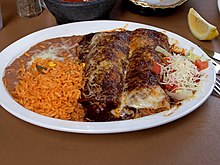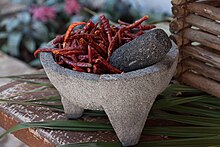Mexican cuisine
The Mexican cuisine is characterized by the synthesis of mainly pre-Columbian and Spanish, but also French, Arab and Caribbean traditions. Corn, beans, (mild) chilies, fruits and certain types of vegetables play a dominant role. There are various regional cuisines in Mexico that differ significantly from one another. In the north, the influence of Spanish cuisine prevails , while in the south the indigenous cuisine has been more preserved. Mexican cuisine is recognized as an intangible world heritage site.
history
The pre-Columbian cuisine of the region was shaped by high Indian cultures such as that of the Aztecs , the Huaxteks and other Maya peoples, the Otomí , the Purépecha and the Zapotecs . Mexico is the origin of some plants that have spread all over the world - these include cocoa and vanilla in particular , but also avocado , tomatoes , chilli and corn . Traditionally, all dishes were based on corn, which was so precious that the Aztecs worshiped a special corn god . In second place was the chilli, which was used for seasoning. There was also bottle gourd / calabash , beans and, depending on the region, game (especially peccary , but also rabbits and rodents and iguanas ). Initially only dogs and turkeys were kept as pets .
Certain flowers such as “Flor de Calabaza” (pumpkin or zucchini flowers) and parts of the multi-limbed opuntia (e.g. the leaves) were and are on the menu. The agave is used in a variety of ways: the sweet juice is used to sweeten, fermented, however, it was an intoxicating drink with partly ritual character. In modern times it is sold distilled as mezcal .
After the conquest and colonization by the Spaniards, new dishes emerged, especially pork and lard, beef , rice and sugar . The Spaniards also tried to replace corn as a staple food with wheat , because corn also played an important role in the original religion of the inhabitants. However, their efforts were unsuccessful, not least because corn thrives better in the country's climatic conditions. Wheat bread, however, became a food for the rich.
The Spaniards also introduced cattle breeding in Mexico. Cattle, sheep, goats, pigs and chickens were kept from then on. During the colonial period, the wealthy elite adopted the Spanish preference for mutton , while the bulk of the population ate beef . In the 19th century, French cuisine gained influence, leading to a general preference for beef. During this period, olive oil became popular for cooking, supplanting lard and butter.
The Mexican national dish is Mole Poblano , a dish with turkey or chicken, topped with a special, eponymous sauce made from chilli, various spices and some chocolate . The origin of this dish is not exactly clear. In the 1920s, anthropologist Margaret Park Redfield argued that it was a recipe that was known to the natives before the Spanish conquest. In the 1970s, however, Judith Friedlander came to the conclusion that it was of Spanish origin due to the spices used. A third theory is that Mole Poblano was invented by Spanish nuns in the city of Puebla .
Immigrants from various countries have influenced Mexican cuisine. In the 18th century, for example, it was Italians from the Naples region who founded pasta factories in Mexico City as early as 1790 . German immigrants opened breweries and popularized beer as a drink. In the 19th century, the upper class oriented itself towards French cuisine . In the recent past, US fast food has gained a strong influence.
Mexico submitted an application to UNESCO to have its important culinary culture recognized as a cultural heritage, which was granted. It should be noted that a large number of kitchen and cooking styles with their own specialties have developed in the various parts of the country. Particularly noteworthy are the Cocina Poblana , Cocina Veracruzana , Cocina Oaxaqueña , Cocina Chiapaneca and Cocina Yucateca . The Tex-Mex is sometimes associated with the Mexican cuisine. However, this is a food culture from the USA .
In the 1950s, the so-called nueva cocina mexicana developed, the “new Mexican cuisine”, which combines traditional ingredients of native cuisine with techniques of international haute cuisine . One example is a corn and mushroom dish, served in crepes with bechamel sauce , invented by chef Jaime Saldívar. In the 1990s, fusion food became popular, mixing Mexican dishes with elements from various international cuisines such as: B. Huauhzontle Pesto . This new style was heavily influenced by female chefs.
General
The most important meal for the urban population is lunch, and the lunch break on a normal working day is correspondingly long. The upper classes are based on the meal structure of Spanish cuisine. Breakfast usually only consists of coffee and a roll or sweet pastries. A few hours later there is a snack that can consist of chilaquiles , dried, deep-fried, mostly triangular tortilla strips ("totopos") in a mild red or green chilli sauce with onion strips, cream and cheese, or an egg dish. This second breakfast is particularly popular on Sundays. In contrast to Spain, however, lunch around 3 p.m. is the main meal. It can consist of four courses, namely soup, then rice or spaghetti , a meat dish and finally a dessert. A lemonade (agua fresca) is drunk with it. In the evening, usually only a small snack is consumed, for example a sweet roll, tacos or an “antojito” (see below). On special occasions, there is a rich dinner late in the evening, which is often eaten outside the house. Young people often meet at taco stalls in the evenings. There are numerous recipes for preparing tacos (rolled tortilla with filling). The rural population of campesinos and the poorer sections of the population usually only eat two meals a day, namely breakfast and dinner. At lunchtime there is only one snack.
Regionally, there are also big differences between the coast and the central highlands in Mexico. By the sea there are more fish dishes like ceviche . In the north you can feel the influence of Tex-Mex cuisine . People eat more meat: mutton (cabrito) or dry beef (machaca). The food is also less spicy. In contrast to Tex-Mex cuisine, meals rarely consist of mixed dishes, for example the rice is often eaten before the meat, not with it.
Corn tortillas are eaten with almost every dish in southern Mexico , whereas wheat tortillas in northern Mexico. These are relatively thin flat cakes that are served warm. They can also be touched as a side dish, but they are often already filled and served with sauce. Antojitos are tortilla-like products that are also made from corn and offered as snacks. You can often get them on the street and at stalls. An example are quesadillas (tortillas fried in fat with a cheese filling and often other ingredients).
Typical dishes
Well-known dishes are Mole Poblano and Chiles en nogada from Puebla, Huachinango a la Veracruzana (a fish dish from Veracruz ), Cochinita Pibil (a goulash- like dish with pork and "achiote" ( Annatto ) from the Yucatán region ), and Pozole (a soup-like dish with chicken or pork and large nixtamalized corn kernels from Jalisco ). Tamales wrapped in banana or corn leaves are also known, the preparation of which varies depending on the region. The guacamole , a type of dip that is eaten with tortilla chips ( totopos ), with meat or instead of sauces , is very popular . A particular specialty is cuitlacoche , a delicate mushroom that grows as a corn parasite .
Chili con carne and nachos are not Mexican, but Texan dishes, where today's Texas is former Mexican territory. They are part of Tex-Mex cuisine and are largely unknown in Mexico.
chili
Mexico is the original home of the chillies, which is why there is the greatest variety in the world with around 90 different varieties. The country is also a world leader in consumption, as many Mexican dishes are made with (not necessarily hot) chilies. Chili is eaten with many meals, usually in the form of sauces. The “Chile Habanero ” comes from Yucatán , which is very hot and is therefore often served in a kind of vinaigrette. Another very hot chili is the "Chile de Árbol". The “Chile Chipotle”, a smoked jalapeño chili that is often used for albóndigas (meatballs in a tomato sauce), is popular for cooking . Very often people cook with the "Chile Serrano", which can be found in many sauces, for example the Salsa Roja with red tomatoes and the Salsa Verde , which is prepared with a type of green tomato (Tomatillo).
Only the "Chile Poblano" (a large green pepper) is used as a separate dish, which is filled with either meat or cheese. Also known are the Chiles en Nogada , where the chile poblano is filled with minced meat and dried fruits and covered with a sauce made from skinned walnuts, cream and pomegranate seeds . This also gives the dish the national colors of the flag: green the chilli, white the cream sauce and red the seeds.
Candy and ice cream
Mexico is the origin of many typical sweets, the best known from the Michoacán and Guanajuato area . The cajeta , a thick sauce made from sweetened, caramelized goat's milk, is very popular . It is often served between two wafers called morelianas . There are also many milk-based sweets ( dulces de leche ), often in combination with pieces of nuts, mostly pecans. Also popular are cocadas , which are prepared with coconut and sometimes egg yolk, confectionery made from tamarind , alegrías made from amaranth and palanquetas , bars made from various caramelized seeds or nuts such as pistachios or peanuts. The combination of sweet and spicy is also popular in Mexico, for example chilli-tamarind lollipops.
The range of ice cream is very varied. In addition to ice cream ( helados ) made from milk and water ice, there are also sorbets ( nieves , literally “snow”) and raspados (ice cream freshly grated from a large block and poured over with sweet syrup). These are sometimes refined with the fruits available on site, including corn and avocado.
beverages
Beer , tequila , mezcal or pulque are the usual alcoholic drinks. Mezcal is obtained from a smaller type of agave . The famous worm (actually a butterfly larva) in Mezcal is almost exclusively put into the bottles intended for export. Originally it was dried, pulverized and consumed with a drink instead of salt.
The horchata introduced by the Spaniards is a popular drink, a sweet drink that, unlike the Spanish original, is not made on the basis of tiger nuts, but with rice, and is then refined with cinnamon and served chilled. “Agua de Jamaica” (a mostly sweetened hibiscus flower tea ) and less often “Agua de Tamarindo ” are also offered. A lot of lemonade is also drunk in Mexico . The country is also said to have the highest per capita consumption of Coca-Cola in the world. Tascalate is a traditional cocoa drink from the state of Chiapas, which, among other things, is given its taste by ground pine nuts and vanilla.
literature
- Lupida Castaneda (text and recipes) and Tina Kraus (illustrations): The Mexico cookbook: pictures, stories, recipes . Publishing house Jacoby & Stuart, Berlin 2014, ISBN 978-3-942787-38-3 .
- Guadalupe Rivera and Marie-Pierre Colle: Mexican Festivals: The Fiestas of Frida Kahlo . Christian, Munich 1998, ISBN 3-88472-398-7 .
Web links
Individual evidence
- ↑ Latin America - Quetzal Editor: Mexico: UNESCO makes Mexican cuisine a World Heritage Site . In: Quetzal Leipzig . ( quetzal-leipzig.de [accessed on February 11, 2017]).
- ↑ Beate Engelbrecht, Ulrike Keyser: Mexican Cooking - Dishes and their History , Edition Diá, St. Gallen, Berlin, São Paulo, 1991, ISBN 3-905482-69-X



